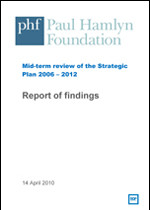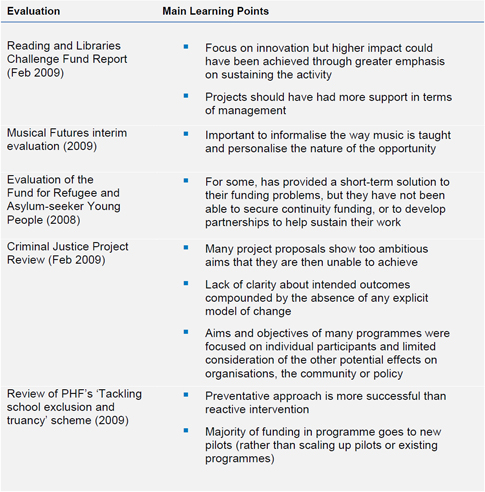6 Cross cutting questions
6.1 What is the Foundation learning and how is it using and transferring that knowledge?
Work with one hand, wave with the other.
Persian saying, quoted by Trustee
The Foundation is learning to be strategic investor; it is developing its own distinctive approach. This is a ‘bottom up/top down’ approach which works simultaneously through demonstration (practice) and persuasion (policy and advocacy) to address social challenges or grasp opportunities and that bring about systemic change. This approach requires both the structured approach of the Special Initiative and the more responsive Open Grants.
The individual Special Initiatives are also generating a great deal of learning and increased understanding. Some of this is captured in recent evaluation reports, as listed below.
Main learning Points from existing evaluations
Communicating and transferring knowledge
The recently produced communications strategy sets out more comprehensive approach to transferring knowledge based on what the Foundation has learnt over the past four years. There are four main strands of activity:
- Support of grants cycle: a new applications system, development of website support information, grantee communications – email newsletter and the Yearbook (a widely admired publication)
- Profile: PR/media Agreement on enhanced media strategy
- Support for Special Initiatives through: publications, micro-sites, newsletters PR/media, events
- Building greater capability for measuring impact: website use analysis Grantee Perception Report, feedback mechanisms, e.g. for yearbook, media monitoring
The launch of the new website in Spring 2010 completes a lengthy phase of ‘infrastructure development’ aimed at enabling the Foundation to effectively communicate its messages through appropriate, up-to-date channels.
With these in place, the future focus is on maintaining and increasing output through these channels and pursuing greater external profile through increased dissemination of learning – including media engagement, increased publishing output (in conjunction with the Research, Knowledge and Improvement Strategy) and events.
6.2 What is the relative contribution of Special Initiatives and Open Grants to the achievement of the objectives of the Strategic Plan?
In the light of the above, does further consideration need to be given to the balance between Special Initiatives and Open Grants?
While Open Grants and Special Initiatives are a very different approach to grant giving in an operational sense, drawing a sharp distinction between the two does not give a true representation of the way the Foundation works. Special Initiatives include grants to smaller projects/organisations, whose role it is to provide fresh new approaches to problems. Open Grants can be strategic or, at least, tactical, as well as large: for example, to the South Bank Centre or Sistema. The Education and Social Justice programme have ‘theme’ Open Grants around strategic issues.
The interplay between the two is an important part of the strategic philanthropy that PHF is exploring for itself by implementing the Strategic Plan. The 50/50 target – which will be achieved next year – set out in the Strategic Plan is as good a starting point as any. The majority view across the advisors, trustees and stakeholders were that the Special Initiatives approach is more likely to produce demonstrable long-lasting change at the end of period – and beyond – but that it is good to have an inter-play between this and the more responsive approach of Open Grants.
Do we go for the more bureaucratic and directed approach of the Sis or the more responsive, freer approach of the Open Grants? It’s actually good to have both. But it’s a tightrope to walk, keeping the balance. I think the balance is about right at present.
Advisor
Special Initiatives or Open Grants? It’s not a theological question. What matters is supporting good organisations and good projects.
Trustee
6.3 Is the allocation of resources between programmes appropriate and fit for purpose?
The allocation of resources across the programmes is not seen as a major issue by most consultees, including trustees. Most of the external stakeholder consulted thought that it made sense, given the Foundation’s three overlapping core aims, to have roughly even expenditure across the three main programme areas.
As the findings of this review show, the bigger question for each programme is the time and resources required on activities over and beyond the core business of grant-giving, in particular the work on Special Initiatives, on capacity building and learning and improvement. This needs further consideration, monitoring and management.
6.4 Is there an appropriate balance between innovation and ‘scaling up’: i.e. are there too many pilots?
All foundations face the question of whether it is better to use their (relatively) modest resources to support new approaches or to support organisations to scale up existing work. Sometimes this might be scaling up an innovation funded by the Foundation. This dilemma is felt across the Foundation. Supporting innovation is a key part of the Strategic Plan. But as a number of trustees remarked, innovation should not be supported for its own sake but to bring in pursuit of the Foundation’s aims.
The evidence from the Grantee Perception Report is that the Foundation is three time more likely than its comparable cohort to support new rather than existing programme activity. Advisors and stakeholders see this as a strength of the Foundation’s work. Is the balance right? There is no simple answer, but it is clear that this question cannot be separated from the related questions concerning the best approach to capacity-building.
6.5 Is the size and speed of the Special Initiatives fit for purpose? Should we consider smaller, faster approaches?
PHF is respected for the rigorous way in which it approaches its Special Initiatives. But they often take longer than planned. This is par for the course in most cases. But there can a danger of losing the moment. There is no reason why smaller Special Initiatives could not be introduced with shorter development cycles. It depends on the opportunity that arises and the nature of the issue/field being addressed. This approach might fit well with a more structured approach to research, knowledge and improvement.
We might need a quicker development cycle: there can be a danger of missing the chance to innovate because the landscape shifts.
Advisor

